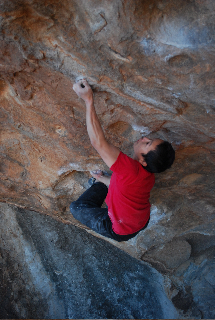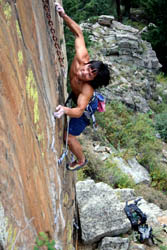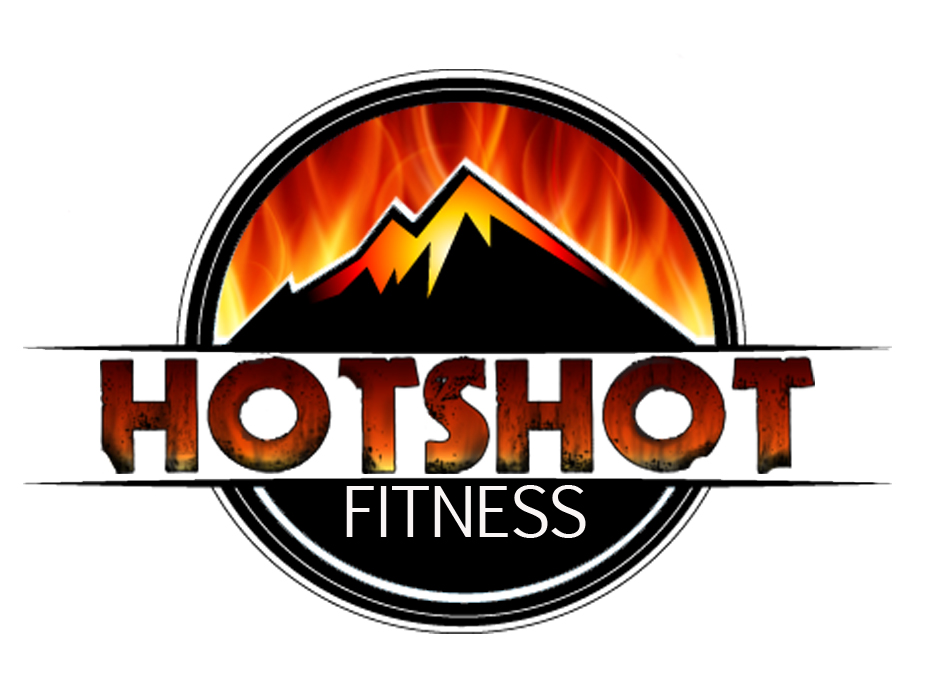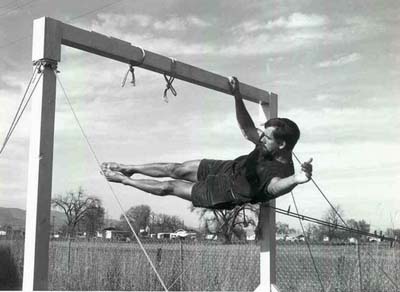 Hotshot Fitness caught up with Tony “T-Nut” Yao while he was kicking back in the mountain mecca of Boulder, Colorado. This rock rat hails from the Lonestar state, and loves two things: his wife Jen, and rock climbing. By day, he’s a route setter at the Boulder Rock Club, an indoor rock gym in Boulder. He also coaches the BRC’s junior climbing team, and serves as a personal climbing trainer to newbies and rope guns (experts) alike. As if that wasn’t cool enough, he burns all his vacation time hopping around the globe, throwing up first ascents with La Sportiva’s ridiculously talented Climbing Team. At 5’5″, he’s not the biggest guy on the mountain, but he’s arguably the toughest. How tough? While climbing a route in Rifle, Colorado, he literally took a fall so gnarly it ripped his finger off. When we heard that bit of folklore, we knew we had to talk.
Hotshot Fitness caught up with Tony “T-Nut” Yao while he was kicking back in the mountain mecca of Boulder, Colorado. This rock rat hails from the Lonestar state, and loves two things: his wife Jen, and rock climbing. By day, he’s a route setter at the Boulder Rock Club, an indoor rock gym in Boulder. He also coaches the BRC’s junior climbing team, and serves as a personal climbing trainer to newbies and rope guns (experts) alike. As if that wasn’t cool enough, he burns all his vacation time hopping around the globe, throwing up first ascents with La Sportiva’s ridiculously talented Climbing Team. At 5’5″, he’s not the biggest guy on the mountain, but he’s arguably the toughest. How tough? While climbing a route in Rifle, Colorado, he literally took a fall so gnarly it ripped his finger off. When we heard that bit of folklore, we knew we had to talk.
HF: How did you get into climbing?
TY: I just finished my freshman year in college, and I went with a buddy to the local climbing gym. We had no idea what we were doing. Fortunately for us, the gym had Petzl GriGri’s attached to the floors and gave us a five minute tutorial. When I got back from summer break, another friend had started climbing, and I soon bought my very own climbing shoes and harness. The rest, as they say, is history. There were many rock climbing guided tours that I wanted to try out because I just couldn’t get enough of it, but mostly I went out on my own exploring the cliffs and the rock sides.
HF: What keeps you amped up and motivated to keep pushing your limits every day?
TY: The thing about rock climbing is there is always room for improvement. Even if I feel strong, I want to feel stronger. Even if I send my recent project, I am looking for the next one. I am planning my training around road trips. I tend to plan my road trips as far in advance as possible It’s an endless cycle of getting fit, so you don’t suck when you are in exotic places like Kalymnos, Greece; Railay, Thailand; or Bariloche, Argentina. I’ve got some great trips planned for next year. I’ve been looking at Salt Lake City RV Rentals and renting an RV seems like a great option for me. If I had an RV, I could stop and climb wherever I wanted. It’s only an idea at the minute though!
HF: Climbing and firefighting are both intense, high-stress activities – what advice do you give to your clients to help them keep their cool when things get dicey?
TY: I try to instill the fact that there are rational and irrational fears to climbing. My clients are climbing indoors and for the most part, the fears of rock climbing indoors are irrational. Sport climbing, especially indoors, is relatively safe, and people’s fears are really unfounded. Essentially, falling in the gym consist of falling anywhere between 5 to 15 feet, sometimes more, with a soft cushiony catch at the end. As long as you have a good belayer, falling on lead in the gym is completely safe. People just fear falling because it is a natural fear and an unnatural sensation when experiencing. But, when one is used to it, falling is just another part of climbing.
HF: For those of us who have never climbed – how exactly do you train for it?
TY: Especially for beginners, the best way to train for climbing is simply to climb. When you first start rock climbing, it’s comparable to a baby taking his/her first steps. The sensation can feel completely foreign, and it can feel really, really hard. So the best training for beginner climbers is to get the awkward feeling out of your system. Just climb! Watch the movement of experienced climbers and the likes of Colorado mountain guides that have years of experience on certain routes. Watch how fluid they move. Before you know it, you will be moving smoothly and fluidly.
 HF: I don’t care what anyone says: nobody is completely unafraid of heights. It’s got to get scary sometimes – how do you cope with that fear?
HF: I don’t care what anyone says: nobody is completely unafraid of heights. It’s got to get scary sometimes – how do you cope with that fear?
TY: Again it’s all about rational and irrational fears. You over compensate for instinctual fear with logical talks inside your head. It doesn’t always work, but hopefully you can win the battle in your head. Climbing on the same routes also allows one to get more comfortable with falling. Your body gets use to the stressful movements, and before long all you are thinking about is the climbing and not the falling part.
HF: Any tips on avoiding injuries while training?
TY: Climbing involves a lot of pulling muscles; back and biceps. You see a lot of climbers that are very one dimensional; they have huge backs but tiny legs and no chest. Being well rounded really helps not only your overall fitness but keeps you from taking months of rest because of tendonitis or a ruptured finger pulley. Climbing training, unless you are a mutant, is finite. Resting those body parts specific to climbing is essential. You have so much time left for everything else, like running, core training, and don’t forget opposition training like pushing muscles such as bench presses and triceps extensions.
HF: What’s the biggest misconception people have about what makes a good climber?
TY: People always think if you have big muscles you can climb really well. I have spent the last fifteen years trying to lose muscle mass! Strength to weight ratio is the optimum balance to rock climbing. You have to be strong AND light! People also do not realize the enormous amount of importance of using your legs and flexibility in climbing. If you can utilize your feet more, you are taking more weight off your arms. My wife can not do more than 5 pull ups, but she can climb 5.12+. People also think the taller you are the better you will be. Well I’ve been climbing a long time, but I have rarely seen a NBA-sized rock climber. It comes back to that strength to weight ratio and leverage. At some point, one can have too long of limbs. That’s why gymnasts are typically small and light. Climbing is the same way.
HF: Endurance is also vital for firefighters. Working 16 hour shifts, day after day is draining – just like pulling your body up a vertical rock wall. What do climbers do to buildup their endurance?
TY: Most climbers do a lot of cross training. I will run four to five times a week besides my climbing schedule. Climbing days are also long and can be arduous. At the end of the day, it is about how far can you break down your muscles, so they can rebuild and become stronger for the next training session.
HF: What are your thoughts on Yoga? Mystic nonsense or daily ritual?
TY: I cannot stress the importance of active flexibility to rock climbing. Yoga is a great tool for flexibility. The ability to focus in yoga can also translate to rock climbing. The late Wolfgang Gullich always said rock climbing is 90% mental and only 10% physical! I absolutely agree.
HF: You’re also quite the runner we hear. Got any advice for breaking plateaus, and keeping it fresh?
TY: I ran my first marathon last year. I felt great! I was psyched with my time, and I thought I would crush on the Bolder Boulder 10k a few weeks later. I was stunned when I did not do that great in the 10k. Duh. Specificity to training is so key. If you want to climb for long alpine routes then there is no reason to go bouldering except for having fun. Conversely, running marathons do not help you pulling on pebbles.
HF: How do you stay in climbing shape over the winter?
TY: Boulder Rock Club! Training indoors is so convenient! You can come in and get a full days work out in three to four hours. I love it.
HF: How many pull-ups can you do?
TY: Hmmm…. I won a pull up contest a while back. I think I did 28 pull ups in 60 seconds. I don’t really know how many I can do in total… Maybe more?
HF: What’s the most insane display or brute strength you’ve ever witnessed? (1 finger pull-ups, man picking up a car with his tongue, etc.)
TY: I think an old photo of John Gill holding his whole body with a closed hand grip. He seems weightless in that instance. Pretty amazing.
HF: We googled the image, and found it. Here it is, courtesy of Keep It Street Level Blog. Wow.
HF: Least favorite part about training?
TY: Writing it all down! I guess that is not crucial, but it does let you keep track of your progress.
HF: What benefit would firefighters get out of getting into climbing?
TY: I think climbing is such a core building, upper body specific sport, that firefighters could really benefit those anaerobic aspects of climbing. I also think route climbing can really raise your heart rate. Running at your anaerobic threshold is great training in general. Might make you want to throw up, but no biggie.
HF: “Might make you want to throw up but no biggie” he says. If this climbing thing doesn’t work out, you might want to try hotshottin’! It’s no wonder you’re one of the best climbers on the scene. Tony Yao – thanks for shootin’ it with us!
TY: My pleasure!

